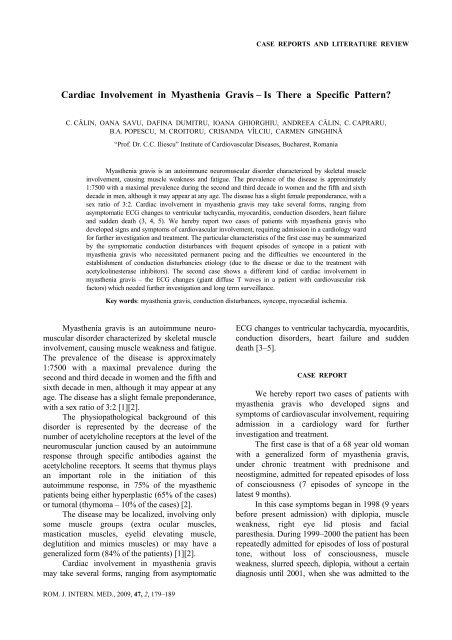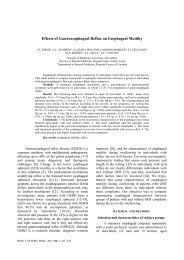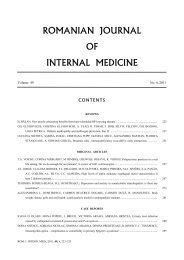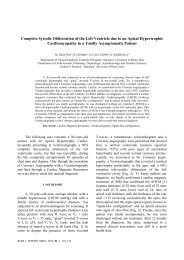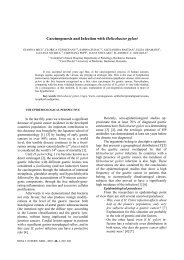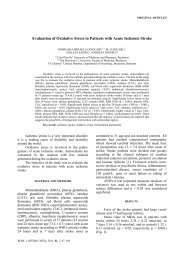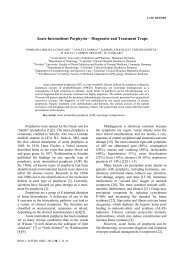Cardiac Involvement in Myasthenia Gravis - Romanian Journal of ...
Cardiac Involvement in Myasthenia Gravis - Romanian Journal of ...
Cardiac Involvement in Myasthenia Gravis - Romanian Journal of ...
Create successful ePaper yourself
Turn your PDF publications into a flip-book with our unique Google optimized e-Paper software.
CASE REPORTS AND LITERATURE REVIEW<br />
<strong>Cardiac</strong> <strong>Involvement</strong> <strong>in</strong> <strong>Myasthenia</strong> <strong>Gravis</strong> – Is There a Specific Pattern<br />
C. CĂLIN, OANA SAVU, DAFINA DUMITRU, IOANA GHIORGHIU, ANDREEA CĂLIN, C. CAPRARU,<br />
B.A. POPESCU, M. CROITORU, CRISANDA VÎLCIU, CARMEN GINGHINĂ<br />
“Pr<strong>of</strong>. Dr. C.C. Iliescu” Institute <strong>of</strong> Cardiovascular Diseases, Bucharest, Romania<br />
<strong>Myasthenia</strong> gravis is an autoimmune neuromuscular disorder characterized by skeletal muscle<br />
<strong>in</strong>volvement, caus<strong>in</strong>g muscle weakness and fatigue. The prevalence <strong>of</strong> the disease is approximately<br />
1:7500 with a maximal prevalence dur<strong>in</strong>g the second and third decade <strong>in</strong> women and the fifth and sixth<br />
decade <strong>in</strong> men, although it may appear at any age. The disease has a slight female preponderance, with a<br />
sex ratio <strong>of</strong> 3:2. <strong>Cardiac</strong> <strong>in</strong>volvement <strong>in</strong> myasthenia gravis may take several forms, rang<strong>in</strong>g from<br />
asymptomatic ECG changes to ventricular tachycardia, myocarditis, conduction disorders, heart failure<br />
and sudden death (3, 4, 5). We hereby report two cases <strong>of</strong> patients with myasthenia gravis who<br />
developed signs and symptoms <strong>of</strong> cardiovascular <strong>in</strong>volvement, requir<strong>in</strong>g admission <strong>in</strong> a cardiology ward<br />
for further <strong>in</strong>vestigation and treatment. The particular characteristics <strong>of</strong> the first case may be summarized<br />
by the symptomatic conduction disturbances with frequent episodes <strong>of</strong> syncope <strong>in</strong> a patient with<br />
myasthenia gravis who necessitated permanent pac<strong>in</strong>g and the difficulties we encountered <strong>in</strong> the<br />
establishment <strong>of</strong> conduction disturbancies etiology (due to the disease or due to the treatment with<br />
acetylcol<strong>in</strong>esterase <strong>in</strong>hibitors). The second case shows a different k<strong>in</strong>d <strong>of</strong> cardiac <strong>in</strong>volvement <strong>in</strong><br />
myasthenia gravis – the ECG changes (giant diffuse T waves <strong>in</strong> a patient with cardiovascular risk<br />
factors) which needed further <strong>in</strong>vestigation and long term surveillance.<br />
Key words: myasthenia gravis, conduction disturbances, syncope, myocardial ischemia.<br />
<strong>Myasthenia</strong> gravis is an autoimmune neuromuscular<br />
disorder characterized by skeletal muscle<br />
<strong>in</strong>volvement, caus<strong>in</strong>g muscle weakness and fatigue.<br />
The prevalence <strong>of</strong> the disease is approximately<br />
1:7500 with a maximal prevalence dur<strong>in</strong>g the<br />
second and third decade <strong>in</strong> women and the fifth and<br />
sixth decade <strong>in</strong> men, although it may appear at any<br />
age. The disease has a slight female preponderance,<br />
with a sex ratio <strong>of</strong> 3:2 [1][2].<br />
The physiopathological background <strong>of</strong> this<br />
disorder is represented by the decrease <strong>of</strong> the<br />
number <strong>of</strong> acetylchol<strong>in</strong>e receptors at the level <strong>of</strong> the<br />
neuromuscular junction caused by an autoimmune<br />
response through specific antibodies aga<strong>in</strong>st the<br />
acetylchol<strong>in</strong>e receptors. It seems that thymus plays<br />
an important role <strong>in</strong> the <strong>in</strong>itiation <strong>of</strong> this<br />
autoimmune response, <strong>in</strong> 75% <strong>of</strong> the myasthenic<br />
patients be<strong>in</strong>g either hyperplastic (65% <strong>of</strong> the cases)<br />
or tumoral (thymoma – 10% <strong>of</strong> the cases) [2].<br />
The disease may be localized, <strong>in</strong>volv<strong>in</strong>g only<br />
some muscle groups (extra ocular muscles,<br />
mastication muscles, eyelid elevat<strong>in</strong>g muscle,<br />
deglutition and mimics muscles) or may have a<br />
generalized form (84% <strong>of</strong> the patients) [1][2].<br />
<strong>Cardiac</strong> <strong>in</strong>volvement <strong>in</strong> myasthenia gravis<br />
may take several forms, rang<strong>in</strong>g from asymptomatic<br />
ECG changes to ventricular tachycardia, myocarditis,<br />
conduction disorders, heart failure and sudden<br />
death [3–5].<br />
CASE REPORT<br />
We hereby report two cases <strong>of</strong> patients with<br />
myasthenia gravis who developed signs and<br />
symptoms <strong>of</strong> cardiovascular <strong>in</strong>volvement, requir<strong>in</strong>g<br />
admission <strong>in</strong> a cardiology ward for further<br />
<strong>in</strong>vestigation and treatment.<br />
The first case is that <strong>of</strong> a 68 year old woman<br />
with a generalized form <strong>of</strong> myasthenia gravis,<br />
under chronic treatment with prednisone and<br />
neostigm<strong>in</strong>e, admitted for repeated episodes <strong>of</strong> loss<br />
<strong>of</strong> consciousness (7 episodes <strong>of</strong> syncope <strong>in</strong> the<br />
latest 9 months).<br />
In this case symptoms began <strong>in</strong> 1998 (9 years<br />
before present admission) with diplopia, muscle<br />
weakness, right eye lid ptosis and facial<br />
paresthesia. Dur<strong>in</strong>g 1999–2000 the patient has been<br />
repeatedly admitted for episodes <strong>of</strong> loss <strong>of</strong> postural<br />
tone, without loss <strong>of</strong> consciousness, muscle<br />
weakness, slurred speech, diplopia, without a certa<strong>in</strong><br />
diagnosis until 2001, when she was admitted to the<br />
ROM. J. INTERN. MED., 2009, 47, 2, 179–189
180<br />
C. Căl<strong>in</strong> et al. 2<br />
local hospital on an emergency basis for severe<br />
dysphagia, mastication problems and dysarthria. The<br />
diagnosis <strong>of</strong> myasthenia gravis was f<strong>in</strong>ally established<br />
after a positive neostigm<strong>in</strong>e test. The presence or<br />
absence <strong>of</strong> antibodies aga<strong>in</strong>st the acetylchol<strong>in</strong>e receptors<br />
could not be established at that po<strong>in</strong>t. Treatment with<br />
neostigm<strong>in</strong>e and theophyll<strong>in</strong>e was started, with a<br />
partial improvement <strong>of</strong> symptoms.<br />
After an uneventful period <strong>of</strong> time the patient<br />
was admitted to the local hospital for an episode <strong>of</strong><br />
loss <strong>of</strong> postural tone without loss <strong>of</strong> consciousness,<br />
right lid ptosis, diplopia, severe dyspnea and<br />
hypotension (BP 60/40mmHg). She was transferred<br />
to the Fundeni Cl<strong>in</strong>ic Institute, where a CT scan was<br />
performed, show<strong>in</strong>g a 5 cm thymic tumor. The patient<br />
underwent thymectomy <strong>in</strong>clud<strong>in</strong>g the resection <strong>of</strong><br />
both the thymic tumor and the <strong>in</strong>vaded pleura; the<br />
f<strong>in</strong>al diagnosis was: “Thymic tumor with <strong>in</strong>vasion<br />
<strong>of</strong> mediast<strong>in</strong>al and visceral pleura (T2N0M0).<br />
Generalized form <strong>of</strong> myasthenia gravis”. Ten sessions<br />
<strong>of</strong> radiotherapy consolidated the treatment. The<br />
outcome was favorable, with the complete remission<br />
<strong>of</strong> diplopia, dysathria, deglutition and mastication<br />
alter<strong>in</strong>g and the significant improvement <strong>of</strong> muscle<br />
weakness and dyspnea.<br />
Between 2002 and 2006 the patient had a<br />
regular follow-up, the evolution be<strong>in</strong>g stationary<br />
with slight <strong>in</strong>termittent relapses <strong>of</strong> the myasthenic<br />
weakness dur<strong>in</strong>g episodes <strong>of</strong> respiratory <strong>in</strong>fections.<br />
Start<strong>in</strong>g from July 2007 until January 2008<br />
the patient had seven episodes <strong>of</strong> syncope, both <strong>in</strong><br />
exertion and while sitt<strong>in</strong>g (<strong>in</strong>clud<strong>in</strong>g sup<strong>in</strong>e), the<br />
latest episode be<strong>in</strong>g two months previous to the<br />
admission <strong>in</strong> our cl<strong>in</strong>ic.<br />
At the admission <strong>in</strong> our cl<strong>in</strong>ic we were fac<strong>in</strong>g<br />
the situation <strong>of</strong> a patient previously diagnosed with<br />
generalized form <strong>of</strong> myasthenia gravis and a<br />
history <strong>of</strong> repeated episodes <strong>of</strong> syncope, without<br />
relationship to exertion, without prodroma, without<br />
ang<strong>in</strong>a or palpitations, with no postcritical motor<br />
deficits. She presented fatigue, dyspnea at less than<br />
ord<strong>in</strong>ary physical exertion and cough with mucopurulent<br />
sputum.<br />
The family history was unremarkable; as classical<br />
cardiovascular risk factors we can mention severe<br />
essential arterial hypertension (highest BP measured<br />
value <strong>of</strong> 180/90mmHg), dyslipidemia and obesity.<br />
Upon admission the physical exam<strong>in</strong>ation<br />
revealed a slightly altered general status, normal<br />
body temperature, plethora, ecchymoses on the legs,<br />
abdom<strong>in</strong>al type obesity. The muscle exam<strong>in</strong>ation<br />
revealed hypotonia and hypok<strong>in</strong>esia with preserved<br />
reflexes, right lid ptosis. The BP was 120/90mmHg,<br />
without postural hypotension, HR 83 bpm, regular<br />
heart sounds without murmurs, palpable pulses,<br />
without peripheral edema or jugular distension.<br />
The patient was <strong>in</strong> mild respiratory distress with a<br />
respiratory frequency <strong>of</strong> about 35/m<strong>in</strong>, course<br />
vesicular sounds and wheezes, cough with mucopurulent<br />
sputum.<br />
The laboratory evaluation revealed leucocytosis<br />
with neutrophilia, <strong>in</strong>terpreted as secondary to the<br />
respiratory <strong>in</strong>fection, dyslipidemia, slightly elevated<br />
blood urea nitrogen and uric acid.<br />
ECG showed s<strong>in</strong>us rhythm, 83bpm, QRS axis<br />
–10°, first degree atrioventricular block, complete<br />
right bundle branch block with secondary ST-T<br />
changes, q wave <strong>in</strong> aVF and DIII leads (Fig. 1).<br />
Fig. 1. – ECG: s<strong>in</strong>us rhythm, 83bpm,<br />
QRS axis –10°, first degree atrioventricular<br />
block, complete right bundle<br />
branch block with secondary ST-T<br />
changes, q wave <strong>in</strong> aVF and DIII leads.
3 <strong>Cardiac</strong> <strong>in</strong>volvement <strong>in</strong> myasthenia gravis 181<br />
Postero anterior chest X-ray showed elevated<br />
diaphragm, bilateral opacities <strong>in</strong> the costophrenic<br />
angles, enlarged cardiothoracic <strong>in</strong>dex, prom<strong>in</strong>ent<br />
aortic knob, right hilar fibrosis – the same aspect as<br />
shown by previous chest X ray films (Fig. 2).<br />
Fig. 2. – Chest X-ray: bilateral opacities <strong>in</strong> the costophrenic<br />
angles, enlarged cardiothoracic <strong>in</strong>dex, prom<strong>in</strong>ent aortic knob,<br />
right hilar fibrosis.<br />
The neurologic evaluation revealed a 6 po<strong>in</strong>t<br />
QMC score (Quantitative <strong>Myasthenia</strong> <strong>Gravis</strong> Score),<br />
a score <strong>of</strong> 39 po<strong>in</strong>ts represent<strong>in</strong>g a significant deficit.<br />
The episodes <strong>of</strong> syncope <strong>in</strong> this case raised<br />
numerous differential problems. The data were<br />
<strong>in</strong>terpreted accord<strong>in</strong>g to the European Society <strong>of</strong><br />
Cardiology guidel<strong>in</strong>es for the management <strong>of</strong><br />
syncope published <strong>in</strong> 2004 [6]. Based on this, the<br />
follow<strong>in</strong>g types <strong>of</strong> syncope were excluded:<br />
• Neurally-mediated syncope – there was no long<br />
history <strong>of</strong> syncope and the episodes were not<br />
related to specific situations like cough, sneeze,<br />
swallow<strong>in</strong>g, defecation, ur<strong>in</strong>ation, visceral pa<strong>in</strong>,<br />
did not occur dur<strong>in</strong>g or after large meals and<br />
were not associated with nausea or vomit<strong>in</strong>g.<br />
• Orthostatic syncope – the episodes <strong>in</strong> this<br />
patient appeared both <strong>in</strong> sup<strong>in</strong>e and orthostatic<br />
position; the exam<strong>in</strong>ation did not reveal orthostatic<br />
hypotension (decrease <strong>of</strong> SBP>20mmHg or<br />
to
182<br />
C. Căl<strong>in</strong> et al. 4<br />
The ECG and ECG Holter monitor<strong>in</strong>g<br />
(show<strong>in</strong>g complete right bundle branch block, first<br />
degree and <strong>in</strong>termittent second degree type 2 2:1<br />
atrioventricular block) raised the suspicion <strong>of</strong> a<br />
possible arrhythmic cause <strong>of</strong> syncope, further<br />
necessitat<strong>in</strong>g the establishment <strong>of</strong> a specific cause:<br />
• Possible ischaemic etiology – due to the presence<br />
<strong>of</strong> q waves <strong>in</strong> aVF and D III leads<br />
• Possible <strong>in</strong>volvement <strong>of</strong> myasthenia gravis <strong>in</strong><br />
the etiology <strong>of</strong> conduction disorder<br />
• Possible iatrogenic etiology due to acetylchol<strong>in</strong>esterase<br />
<strong>in</strong>hibitors for myasthenia gravis.<br />
Ischaemic etiology <strong>of</strong> the conduction disorder<br />
could be excluded based on a coronary angiography,<br />
which was not possible at the time <strong>of</strong> the admission<br />
due to logistic problems. However, this etiology is<br />
less likely, as the patient denied any history <strong>of</strong><br />
ang<strong>in</strong>a and the echocardiography showed normal<br />
LV wall motion at rest.<br />
Based on the cl<strong>in</strong>ical and laboratory data, the<br />
follow<strong>in</strong>g diagnosis was established:<br />
Heart failure III NYHA class<br />
Syncope<br />
First degree atrioventricular block<br />
Intermittent second degree type 2 atrioventricular<br />
block with periods <strong>of</strong> 2:1 AV conduction<br />
Severe essential arterial hypertension, high added risk<br />
Dyslipidemia<br />
Generalized form myasthenia gravis – under chronic<br />
treatment with glucocorticoids and chol<strong>in</strong>esterase<br />
<strong>in</strong>hibitors<br />
Operated thymoma (2002)<br />
Chronic bronchitis – acute exacerbation.<br />
Due to the underly<strong>in</strong>g conduction disorder –<br />
second degree type 2 atrioventricular block – with<br />
symptoms represented by numerous episodes <strong>of</strong><br />
syncope <strong>in</strong> the latest 9 months <strong>in</strong> a patient with<br />
known neuromuscular disorder, permanent pac<strong>in</strong>g<br />
was performed, without periprocedural <strong>in</strong>cidents.<br />
The treatment at discharge <strong>in</strong>cluded the<br />
myasthenia gravis specific treatment with prednisone<br />
20mg daily, neostigm<strong>in</strong>e 45mg daily with scopolam<strong>in</strong>e,<br />
am<strong>in</strong>ophyll<strong>in</strong>e 400mg daily, calcium and<br />
D3 vitam<strong>in</strong>, salt without natrium, gastric protection,<br />
low-dose diuretic, antiplatelet therapy and stat<strong>in</strong>.<br />
The second reported case is that <strong>of</strong> a 69 year<br />
old male patient, who presented speech and<br />
swallow<strong>in</strong>g problems for about 4 years, diagnosed<br />
with myasthenia gravis secondary to a thymoma<br />
6 months before the admission <strong>in</strong> our cl<strong>in</strong>ic. Three<br />
months after the diagnosis <strong>of</strong> myasthenia gravis and<br />
the <strong>in</strong>itiation <strong>of</strong> methylprednisolone and acetylchol<strong>in</strong>esterase<br />
<strong>in</strong>hibitor therapy the patient presented<br />
an episode <strong>of</strong> acute respiratory failure requir<strong>in</strong>g<br />
orotracheal <strong>in</strong>tubation and mechanical ventilation,<br />
without a clear precipitat<strong>in</strong>g factor. The ECG<br />
dur<strong>in</strong>g the monitor<strong>in</strong>g <strong>in</strong> the ICU ward (Fig. 4)<br />
showed s<strong>in</strong>us rhythm, QRS axis 60°, diffuse giant<br />
negative T waves (leads C2-C5, DI, aVL, DII,<br />
DIII, aVF), with a maximum amplitude <strong>of</strong> 17mm <strong>in</strong><br />
lead C4, corrected QT <strong>in</strong>terval <strong>of</strong> 480ms, without<br />
ECG criteria for left ventricular hypertrophy. There<br />
is also loss <strong>of</strong> septal q wave <strong>in</strong> the left leads. In this<br />
context the patient was further admitted <strong>in</strong> a<br />
cardiology ward for evaluation.<br />
Fig. 4. – ECG dur<strong>in</strong>g the myasthenic crisis: s<strong>in</strong>us rhythm, QRS axis 60°, diffuse giant negative T waves (leads C2-C5, DI, aVL,<br />
DII, DIII, aVF), with a maximum amplitude <strong>of</strong> 17mm <strong>in</strong> lead C4, corrected QT <strong>in</strong>terval <strong>of</strong> 480ms.<br />
The patient denied chest pa<strong>in</strong> and had several<br />
classical cardiovascular risk factors: smok<strong>in</strong>g,<br />
arterial hypertension and dyslipidemia.<br />
This type <strong>of</strong> ECG, with giant diffuse T wave<br />
<strong>in</strong>version and prolonged QT <strong>in</strong>terval, recorded <strong>in</strong> a<br />
situation <strong>in</strong> which the cl<strong>in</strong>ical data does not suggest a
5 <strong>Cardiac</strong> <strong>in</strong>volvement <strong>in</strong> myasthenia gravis 183<br />
specific etiology, imposes several electrocardiographic<br />
differentials; this type <strong>of</strong> repolarisation<br />
changes may be seen <strong>in</strong> subendocardic ischaemianecrosis,<br />
central nervous system (CNS) disorders,<br />
pericarditis, myocarditis, obstructive hypertrophic<br />
cardiomyopathy, metabolic abnormalities, coca<strong>in</strong>e<br />
use, pheochromocytoma and hyperventilation.<br />
Chest X-ray showed a normal cardiothoracic<br />
ratio, without pulmonary or pleural abnormalities.<br />
Electrolytic disorders have been ruled out<br />
based on a normal biological panel. Due to the<br />
suspicion <strong>of</strong> myocardial ischaemia the serum<br />
tropon<strong>in</strong> was determ<strong>in</strong>ed (one measurement) –<br />
positive qualitative test.<br />
Based on the universal def<strong>in</strong>ition <strong>of</strong> myocardial<br />
<strong>in</strong>farction the positive diagnosis is made on the<br />
detection <strong>of</strong> the rise and/or fall <strong>of</strong> cardiac<br />
biomarkers together with at least one <strong>of</strong> the<br />
follow<strong>in</strong>g: ischemic symptoms, ECG changes<br />
<strong>in</strong>dicative <strong>of</strong> new ischaemia, new Q waves or<br />
imag<strong>in</strong>g evidence <strong>of</strong> new loss <strong>of</strong> viable myocardium<br />
or new wall motion abnormalities [7].<br />
In this case a second measurement <strong>of</strong> tropon<strong>in</strong><br />
was not available; although tropon<strong>in</strong> is specific for<br />
myocardial necrosis, there are false positive<br />
situations – critically ill patients, especially those with<br />
respiratory failure or sepsis, myocarditis, hypertrophic<br />
cardiomyopathy and so on.<br />
The first echocardiography showed the<br />
absence <strong>of</strong> regional wall motion abnormalities, but<br />
revealed moderate concentric left ventricular<br />
hypertrophy (<strong>in</strong>terventricular septum 13mm,<br />
posterior wall 13mm) (Fig. 5a and 5b) and normal<br />
left ventricular systolic function. The left ventricular<br />
hypertrophy was considered secondary to the<br />
arterial hypertension, a diagnosis <strong>of</strong> hypertrophic<br />
cardiomyopathy be<strong>in</strong>g considered unjustified <strong>in</strong><br />
this case. A small subendocardic necrosis could not<br />
be elim<strong>in</strong>ated, as <strong>in</strong> this case and especially <strong>in</strong> the<br />
presence <strong>of</strong> LV wall hypertrophy, echocardiography<br />
might not detect subtle wall motion<br />
abnormalities.<br />
Data on giant T wave <strong>in</strong>version shows that<br />
myocardial <strong>in</strong>farction and CNS disorders are major<br />
etiologies. In a series <strong>of</strong> 100 ECGs with T wave<br />
<strong>in</strong>version analyzed by Walder and Spodick [8]<br />
28 patients presented myocardial <strong>in</strong>farction and<br />
23 patients CNS disorders.<br />
In the reported case the cerebral CT scan<br />
was normal.<br />
Therefore, we were not able to determ<strong>in</strong>e a<br />
certa<strong>in</strong> cause <strong>of</strong> the ECG changes, but could not<br />
exclude myocardial necrosis <strong>in</strong> a patient with<br />
multiple cardiac risk factors. Coronary angiography<br />
on an emergency basis was not performed, <strong>in</strong> this<br />
phase the patient be<strong>in</strong>g treated for the acute<br />
respiratory failure; although coronary angiography<br />
is not contra<strong>in</strong>dicated <strong>in</strong> myasthenia gravis, iod<strong>in</strong>e<br />
contrast usage warrants precaution <strong>in</strong> these cases,<br />
as situations <strong>of</strong> muscle weakness exacerbation have<br />
been reported [9].<br />
Fig. 5a. – Transthoracic echocardiography – parasternal long<br />
axis. Interventricular septum 13mm.<br />
Fig. 5a. – Transthoracic echocardiography – parasternal long<br />
axis. Interventricular septum 13mm.<br />
Fig. 5b. – Transthoracic echocardiography – parasternal long<br />
axis; anatomic M-mode. Left ventricle dimensions.<br />
The myasthenic crisis had a favorable outcome<br />
with remission. Dur<strong>in</strong>g the follow<strong>in</strong>g week the ECG<br />
showed no further evolution. Further myocardial<br />
biomarkers determ<strong>in</strong>ations were <strong>in</strong> a normal range.<br />
The physical exam<strong>in</strong>ation <strong>of</strong> the patient after<br />
the myasthenic crisis showed normal BP measurements<br />
under treatment with ACEI and diuretics, without<br />
signs <strong>of</strong> pulmonary or systemic congestion; the<br />
follow<strong>in</strong>g echocardiographic exam<strong>in</strong>ations were similar<br />
to the first one.<br />
Two months after the myasthenic crisis the<br />
ECG shows dynamic changes <strong>in</strong> the anterior leads,<br />
with biphasic T waves <strong>in</strong> leads C2-C6, DI,aVL<br />
(Fig. 6), with no ischaemic or heart failure symptoms.
184<br />
C. Căl<strong>in</strong> et al. 6<br />
Fig. 6. – ECG recorded 2 months after the myasthenic crisis: s<strong>in</strong>us rhythm, biphasic T waves C2-C4, negative T waves C5,<br />
C6, DI, aVL.<br />
One month later the ECG becomes normal<br />
(Fig. 7), without any further changes dur<strong>in</strong>g the<br />
follow<strong>in</strong>g period.<br />
The evolution <strong>of</strong> the ST-T makes hypertrophic<br />
cardiomyopathy even less likely. In this type <strong>of</strong><br />
cardiomyopathy the ECG changes, which may<br />
appear years before the identification <strong>of</strong> left ventricular<br />
hypertrophy [10], do not alter, especially dur<strong>in</strong>g<br />
short periods <strong>of</strong> time.<br />
Fig. 7. – ECG recorded 3 months after<br />
the myasthenic crisis: s<strong>in</strong>us rhythm,<br />
65 bpm, QRS axis 15°, no ST-T changes,<br />
no pathologic Q waves. Corrected QT<br />
<strong>in</strong>terval 350ms.<br />
Thereafter, <strong>in</strong> this case <strong>in</strong> which other causes<br />
<strong>of</strong> giant T waves have been ruled out, a coronary<br />
angiography was performed and showed normal<br />
epicardic coronary arteries (Figs. 8, 9).<br />
Myocardial <strong>in</strong>farction with angiographically<br />
normal coronary arteries is a well-known entity,<br />
with a prevalence <strong>of</strong> 1–12%. It is more frequent <strong>in</strong><br />
young patients and the etiology is still unclear; the<br />
proposed mechanism <strong>in</strong>cludes coronary vasospasm,<br />
thrombosis, platelet dysfunction or vasospastic<br />
syndromes [11]. However, this diagnosis seems<br />
unlikely <strong>in</strong> a 69 year old male with cardiovascular<br />
risk factors, evolv<strong>in</strong>g ECG changes and positive<br />
tropon<strong>in</strong> <strong>in</strong> a situation which may elicit a false<br />
positive result.<br />
In the current situation other disorders with<br />
similar presentation must be considered. The ECG<br />
changes occurred dur<strong>in</strong>g a myasthenic crisis <strong>in</strong> a patient<br />
with myasthenia gravis secondary to a thymoma.<br />
Based on the data about the most frequent cardiovascular<br />
signs and symptoms <strong>in</strong> myasthenia gravis<br />
[3][5][12](Table I) and the data <strong>in</strong> the reported case,<br />
myocarditis should be considered as a differential;<br />
it may be quite frequently encountered <strong>in</strong> patients<br />
with myasthenia gravis, especially <strong>in</strong> the thymoma<br />
associated group (with an up to 61% prevalence <strong>of</strong>
7 <strong>Cardiac</strong> <strong>in</strong>volvement <strong>in</strong> myasthenia gravis 185<br />
histological evidence <strong>of</strong> myocarditis versus 0.6%<br />
prevalence <strong>in</strong> unselected autopsy series) [3].<br />
In this case, although a specific moment <strong>of</strong><br />
acute heart failure is miss<strong>in</strong>g, the f<strong>in</strong>al two<br />
diagnostics considered are myocarditis or NSTEMI<br />
with angiographically normal coronary arteries.<br />
The patient was discharged on medical treatment<br />
for myasthenia gravis (neostigm<strong>in</strong>e, corticosteroids)<br />
and ACE <strong>in</strong>hibitors, diuretic and stat<strong>in</strong>. Until this<br />
article was written the thymectomy has not been<br />
performed yet, so we lack histopathological data.<br />
Fig. 8. – Coronary angiography – RAO – no significant<br />
stenosis <strong>of</strong> the left coronary artery.<br />
Fig. 9. – Coronary angiography – LAO – normal right<br />
coronary artery.<br />
Table I<br />
Cardiovascular disorders <strong>in</strong> patients with myasthenia gravis<br />
(after Gugl<strong>in</strong>[3])<br />
Myocarditis<br />
Giant cell myocarditis<br />
Cor pulmonale<br />
Post thymectomy:<br />
Pericarditis<br />
Arrhythmia<br />
Medication related:<br />
Cyclospor<strong>in</strong>e – arterial hypertension<br />
Chol<strong>in</strong>esterase <strong>in</strong>hibitors:<br />
Bradycardia, asystole<br />
Paroxysmal tachycardia<br />
ECG abnormalities:<br />
Nonspecific ST-T changes<br />
Prolonged QT <strong>in</strong>terval<br />
Arrhythmia<br />
Atrial fibrillation/flutter<br />
S<strong>in</strong>us bradycardia<br />
Bundle branch block<br />
Atrioventricular block<br />
Thymoma related<br />
Post-irradiation <strong>in</strong>jury<br />
DISCUSSION<br />
The aforementioned cases have been chosen<br />
<strong>in</strong> order to underl<strong>in</strong>e the peculiarities and polymorphism<br />
<strong>of</strong> heart <strong>in</strong>volvement <strong>in</strong> myasthenia gravis<br />
and the differential problems that they raised.<br />
The first case portraits a typical myasthenia<br />
gravis, with a classical onset with <strong>in</strong>volvement <strong>of</strong><br />
the cephalic muscles with further generalized<br />
<strong>in</strong>volvement. The positive diagnosis was established<br />
based on the cl<strong>in</strong>ical signs and symptoms and<br />
neostigm<strong>in</strong>e test; due to technical problems the<br />
presence <strong>of</strong> antibodies aga<strong>in</strong>st acetylchol<strong>in</strong>e receptors<br />
was not established; this would have been useful<br />
because cl<strong>in</strong>ical trials have found a connection<br />
between the antibody type and cl<strong>in</strong>ical subtype.<br />
As already mentioned, the pathological<br />
mechanism <strong>of</strong> this disease is the decrease <strong>of</strong> the<br />
acetylchol<strong>in</strong>e receptors at the neuromuscular junction<br />
due to an autoimmune answer mediated through<br />
specific antibodies aga<strong>in</strong>st the acetylchol<strong>in</strong>e receptors.<br />
The acetylchol<strong>in</strong>e receptor has five units (2α, 1β, 1δ,<br />
1γ or ε) around a central pore; the α unit conta<strong>in</strong>s<br />
both the acetylchol<strong>in</strong>e b<strong>in</strong>d<strong>in</strong>g site and the primary<br />
immunogenic site). Anti-AchR antibodies are positive<br />
<strong>in</strong> 85% <strong>of</strong> the generalized form myasthenia gravis<br />
and <strong>in</strong> 50% <strong>of</strong> the ocular form; a negative result<br />
does not exclude the diagnosis, because as far as<br />
40% <strong>of</strong> the cases with negative antibodies have<br />
anti-MuSK (specific muscle k<strong>in</strong>ase) receptors,<br />
which play an important role <strong>in</strong> the post-synaptic<br />
differentiation <strong>of</strong> acetylchol<strong>in</strong>e receptors [1]. The<br />
positive antiMuSK antibodies are more frequently<br />
found <strong>in</strong> female patients and the respiratory and<br />
bulbar muscles are frequently <strong>in</strong>volved. Other<br />
types <strong>of</strong> antibodies <strong>in</strong> myasthenia gravis are antismooth<br />
muscle antibodies (84% <strong>of</strong> the patients<br />
younger than 40 years without thymoma or patients<br />
older than 40 years with thymoma) and striational
186<br />
C. Căl<strong>in</strong> et al. 8<br />
antibodies (antimuscle prote<strong>in</strong> tit<strong>in</strong> and anti<br />
ryanod<strong>in</strong>ic receptor) which connect themselves <strong>in</strong> a<br />
cross l<strong>in</strong>ked pattern on different epitopes on the<br />
skeletal and heart muscles [1]. Almost all patients<br />
with myasthenia gravis and thymoma and half <strong>of</strong><br />
the patients with late onset myasthenia (>50years<br />
old) have these antibodies [1].<br />
A recent study identified correlations between<br />
the cl<strong>in</strong>ical subsets and antibodies type. Anti-Kv1.4<br />
antibodies have been associated with bulbar<br />
<strong>in</strong>volvement, myasthenic crisis, thymoma and<br />
myocarditis and/or myositis; anti-Ach antibodies<br />
correlate with an early onset <strong>of</strong> the disease and<br />
seronegativity is associated with ocular form<br />
myasthenia.<br />
All these data underl<strong>in</strong>e the fact that the<br />
autoimmune answer <strong>in</strong> myasthenia gravis may<br />
<strong>in</strong>volve the myocardium.<br />
Thymus plays an important role <strong>in</strong> the<br />
<strong>in</strong>itiation <strong>of</strong> the autoimmune answer <strong>in</strong> myasthenia<br />
gravis. Antibodies <strong>in</strong> this disease are IgG,<br />
T-lymphocyte dependent. It seems that the myoid<br />
thymic cells, which express acetylchol<strong>in</strong>e receptors,<br />
may serve as an autoantigene source and can trigger<br />
the autoimmune reaction [2]. Thymectomy improves<br />
the symptoms <strong>in</strong> 85%, and <strong>in</strong> 35% <strong>of</strong> the patients they<br />
enter the remission phase without further need <strong>of</strong><br />
medical treatment cont<strong>in</strong>uation [2].<br />
In the first case we presented thymectomy<br />
improved symptomatology, with the complete<br />
disappearance <strong>of</strong> diplopia, dysarthria, deglutition<br />
and mastication problems and the significant<br />
improvement <strong>of</strong> muscle weakness and dyspnea.<br />
The association between myasthenia gravis<br />
and cardiovascular diseases is known for over<br />
100 years, but there is no specific etiologic l<strong>in</strong>k<br />
between the two conditions. Most <strong>of</strong> the data<br />
derive from series <strong>of</strong> patients or case reports.<br />
Gugl<strong>in</strong> and associates [3] studied 108 patients<br />
with myasthenia gravis and found signs <strong>of</strong> cardiac<br />
<strong>in</strong>volvement <strong>in</strong> 16% <strong>of</strong> the cases (atrial fibrillation,<br />
atrioventricular heart blocks, asystole, sudden<br />
death) that could not be expla<strong>in</strong>ed by other causes<br />
and <strong>in</strong>terpreted as due to myocarditis that occurs<br />
dur<strong>in</strong>g the autoimmune <strong>in</strong>volvement. Cl<strong>in</strong>ical signs<br />
<strong>of</strong> unexpla<strong>in</strong>ed cardiovascular <strong>in</strong>volvement occur<br />
especially <strong>in</strong> myasthenia gravis with thymoma<br />
(50%), more <strong>of</strong>ten than <strong>in</strong> myasthenia gravis<br />
without thymoma (only 12%). Arrhythmia is the<br />
most common cl<strong>in</strong>ical manifestation and these<br />
patients are at an <strong>in</strong>creased risk <strong>of</strong> sudden death.<br />
ECG abnormalities may be found <strong>in</strong> 16 to<br />
88% <strong>of</strong> patients with myasthenia gravis; the most<br />
common forms are nonspecific ST-T changes,<br />
abnormal T wave, prolonged QT <strong>in</strong>terval, s<strong>in</strong>us<br />
tachycardia, s<strong>in</strong>us arrhythmia, bundle branch blocks<br />
[3]. Accord<strong>in</strong>g to our data there is only one<br />
reported case <strong>of</strong> transient ECG changes dur<strong>in</strong>g a<br />
myasthenic crisis suggest<strong>in</strong>g anterior acute myocardial<br />
<strong>in</strong>farction [14]. The necropsy <strong>in</strong> that case showed<br />
no coronary abnormalities, but discovered partial<br />
areas <strong>of</strong> <strong>in</strong>terstitial fibrosis.<br />
The mechanism <strong>of</strong> myocardial <strong>in</strong>volvement<br />
<strong>in</strong> myasthenia gravis is still unknown. Some<br />
isolated reports described autoimmune myocarditis.<br />
Similar anatomical changes <strong>in</strong> the myocardium<br />
(focal myocarditis) and skeletal muscles [15] have<br />
led to the idea <strong>of</strong> myocardium <strong>in</strong>volvement <strong>in</strong> the<br />
pathological process <strong>of</strong> the disease.<br />
The earliest evidence <strong>of</strong> heart <strong>in</strong>volvement<br />
goes back to 1901, when Weigert described abnormal<br />
cells <strong>in</strong> the myo- and epicardium <strong>of</strong> a patient with<br />
thymoma. In 1942 Rott<strong>in</strong>o described polymorphic<br />
myocardial histological lesions <strong>in</strong> the myocardium<br />
<strong>of</strong> myasthenia gravis patients, from scarce lymphocytic<br />
<strong>in</strong>filtration, to diffuse myocarditis [16]. The<br />
microscopical lesions <strong>in</strong>clude my<strong>of</strong>ibrillar necrosis,<br />
<strong>in</strong>flammatory changes with edema, hemorrhages,<br />
lymphocytic <strong>in</strong>filtrations, large irregular histiocytes.<br />
These pathological changes are non specific, as they<br />
can also be found <strong>in</strong> thyreotoxicosis, Addison’s<br />
disease and rheumatoid arthritis. Furthermore, the non<br />
specific <strong>in</strong>flammatory changes associated with hypoxia,<br />
hypercapnia and metabolic acidosis associated with<br />
myastenic crisis cannot be neglected [3][17].<br />
Some authors also described myocarditis with<br />
focal cellular <strong>in</strong>filtration, possibly due to antibodies<br />
aga<strong>in</strong>st β1 and β2 receptors, with prolonged QT<br />
<strong>in</strong>terval and non specific ST-T changes [18].<br />
The presence <strong>of</strong> more frequent, more serious<br />
myocardial <strong>in</strong>volvement <strong>in</strong> thymoma patients has<br />
led some <strong>in</strong>vestigators to <strong>in</strong>terprete the myocarditis<br />
<strong>in</strong> these cases as a paraneoplastic phenomenon [3].<br />
Some <strong>of</strong> the non specific ECG changes may be<br />
<strong>in</strong>duced by myocarditis, as autopsy series described<br />
myocardial abnormalities <strong>in</strong> young patients with<br />
myasthenia gravis and ECG changes [7][14].<br />
Besides myocarditis, not always with cl<strong>in</strong>ical<br />
symptoms (especially as one <strong>of</strong> the card<strong>in</strong>al symptoms<br />
<strong>of</strong> myasthenia is fatigue), some cases <strong>of</strong> giant cells<br />
myocarditis with rapid progression have also been<br />
described, more frequent <strong>in</strong> a perioperative sett<strong>in</strong>g.
9 <strong>Cardiac</strong> <strong>in</strong>volvement <strong>in</strong> myasthenia gravis 187<br />
Most <strong>of</strong> the studies concern<strong>in</strong>g ECG changes<br />
and myocardial <strong>in</strong>filtration <strong>in</strong> myasthenia gravis<br />
were conducted before the era <strong>of</strong> coronary<br />
angiography, so that there is difficult to <strong>in</strong>terpretate<br />
them especially <strong>in</strong> thymoma patients, who are<br />
usually older male patients, with a high probability<br />
<strong>of</strong> ischemic heart disease. A contemporary review<br />
<strong>of</strong> these data with modern technique would be <strong>of</strong><br />
real <strong>in</strong>terest.<br />
In the second case we reported, myocarditis is a<br />
plausible cause <strong>of</strong> ECG evolv<strong>in</strong>g changes <strong>in</strong> the<br />
context <strong>of</strong> angiographically normal coronary arteries.<br />
Some technical limits <strong>in</strong> the paracl<strong>in</strong>ical<br />
<strong>in</strong>vestigations have led to the impossibility <strong>of</strong><br />
establish<strong>in</strong>g a certa<strong>in</strong> diagnosis: lack <strong>of</strong> quantitative<br />
measurements <strong>of</strong> tropon<strong>in</strong> level <strong>in</strong> dynamics, lack<br />
<strong>of</strong> ECG for comparison, BNP measurement <strong>in</strong> the<br />
acute episode, <strong>of</strong> myocardial sc<strong>in</strong>tigraphy with<br />
monoclonal Indium labeled antimyos<strong>in</strong> antibodies<br />
or Galium sc<strong>in</strong>tigraphy or cardiac MRI exam.<br />
A recent study [19] suggested that functional<br />
changes are frequent <strong>in</strong> myasthenia gravis. Autonomous<br />
nervous system, both sympathetic and parasympathetic,<br />
is affected <strong>in</strong> myasthenia gravis, but<br />
the impact <strong>of</strong> these changes on heart function is<br />
still unclear. It has also been proven that the<br />
patients with myasthenia gravis and autoimmune<br />
autonomous neuropathy [20] have antibodies<br />
aga<strong>in</strong>st the nicot<strong>in</strong>ic receptor for acetylchol<strong>in</strong>e<br />
located <strong>in</strong> the skeletal muscle (a classical f<strong>in</strong>d<strong>in</strong>g <strong>in</strong><br />
myasthenia gravis) and specific antibodies aga<strong>in</strong>st<br />
the acetylcol<strong>in</strong>e receptors located <strong>in</strong> the ganglia on<br />
the nerves. This f<strong>in</strong>d<strong>in</strong>g may expla<strong>in</strong> the rare, but<br />
possible cl<strong>in</strong>ical association between myasthenia<br />
gravis and autonomous system dysfunction.<br />
Another important part is the possible<br />
iatrogenic heart <strong>in</strong>volvement dur<strong>in</strong>g treatment with<br />
chol<strong>in</strong>esterase <strong>in</strong>hibitors which may cause<br />
bradycardia, hypotension, syncope, atrioventricular<br />
heart blocks due to the <strong>in</strong>creased quantity <strong>of</strong><br />
acethylcol<strong>in</strong>e <strong>in</strong> the synapse. Some reports mention<br />
cases <strong>of</strong> vasospastic ang<strong>in</strong>a [21], acute myocardial<br />
<strong>in</strong>farction due to coronary artery spasm dur<strong>in</strong>g the<br />
col<strong>in</strong>ergic crisis [22] and proarrythmic effects <strong>of</strong><br />
chol<strong>in</strong>esterase <strong>in</strong>hibit<strong>in</strong>g drugs [23].<br />
In the first reported case we do not have enough<br />
data to strictly l<strong>in</strong>k the conduction abnormalities to<br />
the pathogeny <strong>of</strong> the disease (myocarditis or<br />
autonomous nervous system dysfunction) because<br />
<strong>of</strong> lack <strong>of</strong> immunologic panel <strong>of</strong> the patient. The<br />
patient followed a long treatment (2001–2008) with<br />
col<strong>in</strong>-esterase <strong>in</strong>hibitors, a iatrogenic etiology must<br />
be considered <strong>in</strong> this case, with no possibility <strong>of</strong><br />
stopp<strong>in</strong>g or decreas<strong>in</strong>g the dosage due to the<br />
relaps<strong>in</strong>g <strong>of</strong> myasthenic symptoms.<br />
In the cases <strong>of</strong> symptomatic heart blocks with<br />
syncope <strong>in</strong> patients with myasthenia gravis under<br />
treatment with col<strong>in</strong>esterase <strong>in</strong>hibitors the usual<br />
management implies permanent pac<strong>in</strong>g, as <strong>in</strong> the<br />
described case.<br />
A recent published case report describes the<br />
situation <strong>of</strong> a patient with myasthenia gravis under<br />
piridostigm<strong>in</strong>e treatment who developed high grade<br />
atrioventricular block with frequent episodes <strong>of</strong><br />
syncope. In this case the authors chose the<br />
simultaneous treatment with hiosciam<strong>in</strong>e, a<br />
muscar<strong>in</strong>ic antagonist used to block the deleterious<br />
chol<strong>in</strong>ergic side effects. Under the association <strong>of</strong><br />
therapy the atrioventricular block completely<br />
disappeared, there was no further syncope, thereafter<br />
avoid<strong>in</strong>g the permanent pac<strong>in</strong>g. This situation is an<br />
isolated report, moreover the treatment with<br />
hiosciam<strong>in</strong>e is not available <strong>in</strong> Romania.<br />
There is also a case report <strong>of</strong> atrioventricular<br />
block and pericardial effusion <strong>in</strong> a myasthenia gravis<br />
patient, with favourable course under immunosuppressive<br />
therapy and plasmapheresis [4].<br />
In the first case we considered that the patient<br />
had an <strong>in</strong>creased risk <strong>of</strong> sudden death, no matter<br />
the cause <strong>of</strong> the conduction abnormalities and<br />
chose a permanent pac<strong>in</strong>g attitude, even if the<br />
current guidel<strong>in</strong>es do not <strong>in</strong>clude myasthenia gravis<br />
among the neuromuscular disorders with conduction<br />
abnormalities that impose pac<strong>in</strong>g. Accord<strong>in</strong>g to the<br />
ACC/AHA 2002 guidel<strong>in</strong>es for implantation <strong>of</strong><br />
cardiac pacemakers and antiarrhythmia devices the<br />
pac<strong>in</strong>g <strong>in</strong>dication <strong>in</strong> our patient is class IIb, level <strong>of</strong><br />
evidence B. The guidel<strong>in</strong>es mention that <strong>in</strong><br />
neuromuscular disorders like myotonic muscular<br />
dystrophy, Kearns Sayre syndrome, Erb dystrophy<br />
and peronier muscular atrophy, the presence <strong>of</strong> an<br />
atrioventricular block <strong>of</strong> any grade (<strong>in</strong>clud<strong>in</strong>g grade<br />
I atrioventricular block) with or without symptoms<br />
permanent pac<strong>in</strong>g is <strong>in</strong>dicated given the impredictable<br />
progression <strong>of</strong> conduction abnormalities <strong>in</strong> these<br />
patients. Accord<strong>in</strong>g to the ESC Pac<strong>in</strong>g and CRT<br />
Guidel<strong>in</strong>es, neuromuscular disorders with second or<br />
third degree atrioventricular block represent a class I<br />
level <strong>of</strong> evidence B recommendation for cardiac<br />
pac<strong>in</strong>g, while the association with first-degree<br />
atrioventricular block is a class IIb level <strong>of</strong> evidence<br />
B recommendation.
188<br />
C. Căl<strong>in</strong> et al. 10<br />
The particular characteristics <strong>of</strong> the first case<br />
may be summarized as follows:<br />
The symptomatic conduction disturbances with<br />
frequent episodes <strong>of</strong> syncope <strong>in</strong> a patient with<br />
myasthenia gravis who necessitated permanent pac<strong>in</strong>g.<br />
The difficulties we encountered <strong>in</strong> the<br />
establishment <strong>of</strong> conduction disturbances etiology<br />
(due to the disease or to the treatment with<br />
acetylchol<strong>in</strong>esterase <strong>in</strong>hibitors).<br />
The second case shows a different k<strong>in</strong>d <strong>of</strong><br />
cardiac <strong>in</strong>volvement <strong>in</strong> myasthenia gravis – the<br />
ECG changes (giant diffuse T waves <strong>in</strong> a patient<br />
with cardiovascular risk factors) which needed<br />
further <strong>in</strong>vestigation and long term surveillance.<br />
Miastenia gravis este o boală musculară autoimună caracterizată pr<strong>in</strong><br />
slăbiciune şi oboseală musculară. Prevalenţa bolii este de aproximativ 1:7500 cu<br />
maxim în decadele 2 şi trei la femei şi c<strong>in</strong>ci şi şase la bărbaţi, deşi poate apare la<br />
orice vârstă. Boala are o uşoară predom<strong>in</strong>anţă fem<strong>in</strong><strong>in</strong>ă cu un sex ratio de 3:2.<br />
Afectarea cardiacă în miastenia gravis poate lua câteva forme, mergând de la<br />
modificări EKG asimptomatice la tahicardie ventriculară, miocardită, tulburări de<br />
conducere, <strong>in</strong>suficienţă cardiacă şi moarte subită (3, 4, 5). Vă prezentăm în<br />
cont<strong>in</strong>uare două cazuri de miastenia gravis care au dezvoltat semen şi simptome de<br />
afectare cardiovasculară care au necesitat <strong>in</strong>ternare într-un serviciu de cardiologie<br />
pentru evaluare şi tratament. Astfel, primul caz este particular pr<strong>in</strong> prezenţa<br />
tulburărilor de conducere simptomatice, cu frecvente s<strong>in</strong>cope care au necesitat<br />
cardiostimulare permanentă precum şi pr<strong>in</strong> dificultatea stabilirii etiologiei tulburării<br />
de conducere (datorată bolii în s<strong>in</strong>e sau tratamentului cu <strong>in</strong>hibitori de acetilcol<strong>in</strong>esterază).<br />
Cel de-al doilea caz prez<strong>in</strong>tă afectarea cardiacă manifestată pr<strong>in</strong><br />
modificări de ischemie difuze, care a necesitat <strong>in</strong>vestigaţii suplimentare şi urmărire.<br />
Correspond<strong>in</strong>g author: Carmen G<strong>in</strong>gh<strong>in</strong>ă, MD, PhD, FESC, FACC<br />
100, V. Lascăr Str.<br />
020506 Bucharest, Romania<br />
E-mail: carmeng<strong>in</strong>gh<strong>in</strong>a2001@yahoo.com<br />
REFERENCES<br />
1. AASHIT K. SHAH, MD, <strong>Myasthenia</strong> <strong>Gravis</strong>, Emedic<strong>in</strong>e, 10, 2006.<br />
2. FAUCI A., BRAUNWALD E., KASPER D., Harrison’s Pr<strong>in</strong>ciples <strong>of</strong> Internal Medic<strong>in</strong>e, Ed. 16, McGraw-Hill.<br />
3. GUGLIN M., CAMPELLONE J., HEINTZ K., PARILLO J., <strong>Cardiac</strong> disease <strong>in</strong> myasthenia gravis: a literature review. J. Cl<strong>in</strong>.<br />
Neuromusc. Dis., 2003; 4:199–203.<br />
4. HEMENDER S., MD, RICHARDSON, STEVEN K., Pericarditis <strong>in</strong> <strong>Myasthenia</strong> <strong>Gravis</strong>, Cardiology <strong>in</strong> Review, 2004,<br />
12(3):134–137.<br />
5. BRAUNWALD E., LIBBY P., BONOW R., MANN D., ZIPES D., Braunwald’s Heart Disease – A Textbook <strong>of</strong> Cardiovascular<br />
Medic<strong>in</strong>e, Ed. 8, Saunders, 2007: 2149.<br />
6. BRIGNOLE M., ALBONI P., BERGFELDT L., BLANC J., Guidel<strong>in</strong>es on Management (Diagnosis and Treatment) <strong>of</strong> Syncope-<br />
Update 2004, Europace (2004), 6, 467–537.<br />
7. THYGESEN K., ALPERT J., WHITE D. on behalf <strong>of</strong> the Jo<strong>in</strong>t ESC/ACCF/AHA/WHF Task Force for the redef<strong>in</strong>ition <strong>of</strong><br />
Myocardial Infarction. Universal def<strong>in</strong>ition <strong>of</strong> myocardial <strong>in</strong>farction. EHJ 2007; 28(20):2525–2538.<br />
8. WALDER L.A., SPODICK D.H., Global T wave <strong>in</strong>version. J. Am. Coll. Cardiol., 1991; 17:1479.<br />
9. FRANK J.H., COOPER G.W., BLACK W.C., PHILLIPS L.H., 2 nd , Iod<strong>in</strong>ated contrast agents <strong>in</strong> myasthenia gravis. Neurology,<br />
1987 Aug., 37(8):1400–1402.<br />
10. APETREI E., RUGINA M., STOIAN I., ALEXANDRU D., COMAN I., GINGHINA C., Should electrocardiographic changes<br />
precede the appearance <strong>of</strong> echocardiographic hypertrophy <strong>in</strong> familial hypertrophic cardiomyopathy (Study <strong>of</strong> 51 families).<br />
Congresul ESC 2007, 1–5 September 2007, Vienna.<br />
11. CHANDRASEKARAN B., KURBAAN A.S., Myocardial <strong>in</strong>farction with angiographically normal coronary arteries. J. R. Soc.<br />
Med., 2002; 95(8):398–400.<br />
12. COHLE S., LIE J.T., <strong>Myasthenia</strong> <strong>Gravis</strong>-Associated Systemic Vasculitis and Myocarditis with <strong>Involvement</strong> <strong>of</strong> the <strong>Cardiac</strong><br />
Conduction Tissue. Cardiovasc. Pathol., 1996; 5:159–162.
11 <strong>Cardiac</strong> <strong>in</strong>volvement <strong>in</strong> myasthenia gravis 189<br />
13. SUZUKI S., UTSUGISAWA K., NAGANE Y., Classification <strong>of</strong> myasthenia gravis based on autoantibody status, Pub. Med..<br />
Arch. Neurol., 2007, 64(8):1121–4.<br />
14. KOHN P.M., TUCKER H.J., KOZOKOFF N.J., The cardiac manifestations <strong>of</strong> myasthenia gravis with particular reference to<br />
electrocardiographic abnormalities. Am. J. Med. Sci., 1965; 249:561–569.<br />
15. HOFSTAD H., OHM O.J., MORK S.J., AARLI J.A., Heart disease <strong>in</strong> myasthenia gravis, Acta Neurologica Scand<strong>in</strong>avica,<br />
1984, 70(3):176–84.<br />
16. ROTTINO A., POPPITTI R., RAO J., Myocardial lesions <strong>in</strong> myasthenia gravis. Arch. Pathol., 1942; 34:557–561.<br />
17. GIBSON T.C., The heart <strong>in</strong> myasthenia gravis. Am. Heart J., 1975; 90(3):389–396.<br />
18. CRAWFORD M.H., DIMARCO J.P., PAULUS W.J., Cardiology, Mosby 2nd edition (December 1, 2003), 22, 1–22.10.<br />
19. ASENSIO E., GOMEZ M., NARVAEZ R., CASTILLO L., Description <strong>of</strong> the rest<strong>in</strong>g electrocardiogram <strong>in</strong> a series <strong>of</strong> patients<br />
with myasthenia gravis, Rev. Invest. Cl<strong>in</strong>., 2003 May–June, 55(3):270–5.<br />
20. VERNINO S., CHESHIRE W.P., LENNON V.A., <strong>Myasthenia</strong> gravis with autoimmune autonomic neuropathy, Auton.<br />
Neuroscience, 2001, 14; 88(3):187–92.<br />
21. SUZUKI M., YOSHII T., OHTSUKA T., Coronary spastic ang<strong>in</strong>a <strong>in</strong>duced by antichol<strong>in</strong>esterase medication for myasthenia<br />
gravis-a case report, Angiology, 2000 Dec.; 51 (12):1031–4.<br />
22. COMERCI G., BUFFON A., BIONDI-ZOCCAI G.G., Coronary vasospasm secondary to hypercol<strong>in</strong>ergic crisis: an iatrogenic<br />
cause <strong>of</strong> acute myocardial <strong>in</strong>farction <strong>in</strong> myasthenia gravis. Int. J. Cardiol., 2006 Nov., 10; 113(2):270–1.<br />
23. LEENDHARDT A., THOMAS O., HAOUALA H., Pro-arrythmia effect <strong>of</strong> pyridostigm<strong>in</strong>e. Apropos <strong>of</strong> a case. Arch. Mal<br />
Coeur Vaiss, 1992 Dec.; 85(12):1853–6.<br />
24. GEHI A., MD, BENATAR M., MD, LANGBERG J., MD, Treatment <strong>of</strong> Pyridostigm<strong>in</strong>e-Induced AV block with Hyosciam<strong>in</strong>e <strong>in</strong><br />
a Patient with <strong>Myasthenia</strong> <strong>Gravis</strong>. <strong>Journal</strong> <strong>of</strong> Cardiovascular Electrophysiology, 2008, 19(2), 214–216.<br />
25. GREGORATOS G., ABRAMS J., EPSTEIN E., ACC/AHA/NASPE 2002, Guidel<strong>in</strong>e Update for Implantation <strong>of</strong> <strong>Cardiac</strong><br />
Pacemakers and Antiarrythmia Devices. Circulation, 2002; 106; 2145–2161.<br />
26. VARDAS E., AURICCHIO A., BLANC J., DAUBERT J.C., Guidel<strong>in</strong>es for cardiac pac<strong>in</strong>g and cardiac resynchronization<br />
therapy <strong>of</strong> the European Society <strong>of</strong> Cardiology, European Heart <strong>Journal</strong>, 2007, 28, 2256–2295.<br />
Received March 15, 2009
190<br />
C. Căl<strong>in</strong> et al. 12


